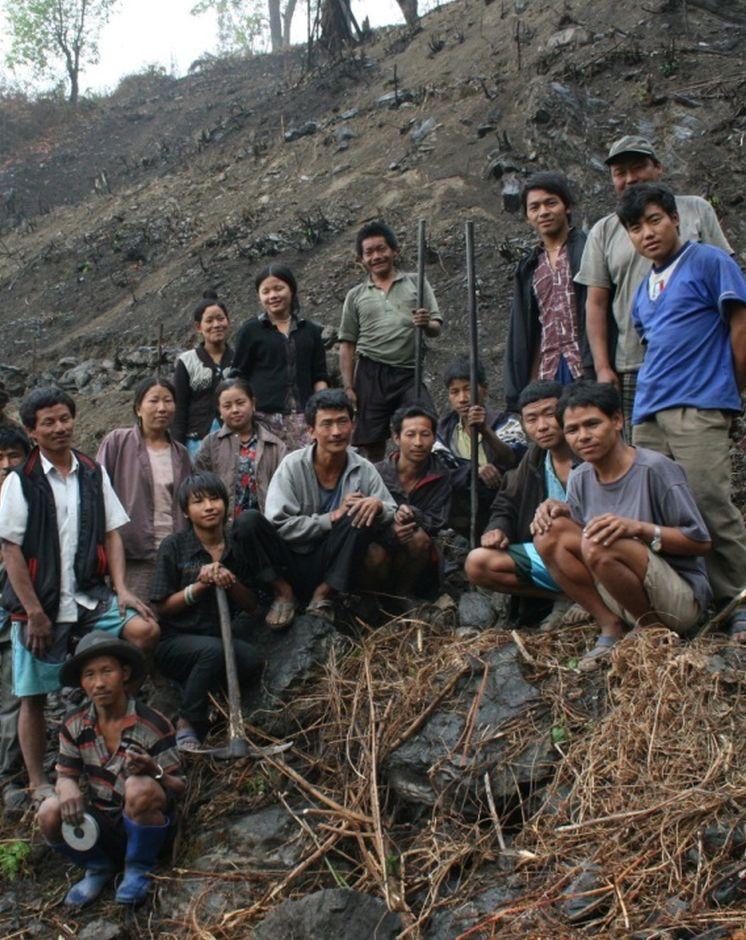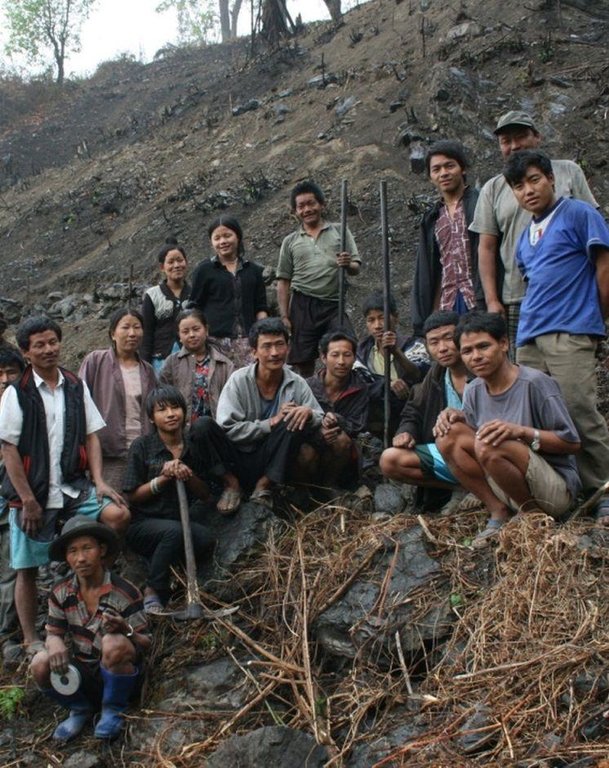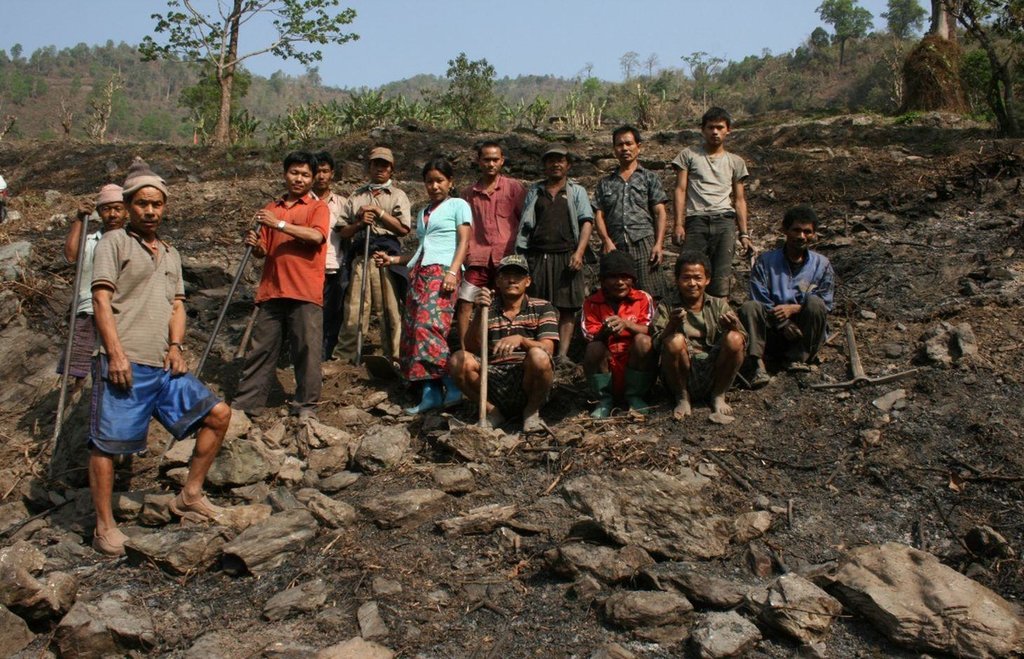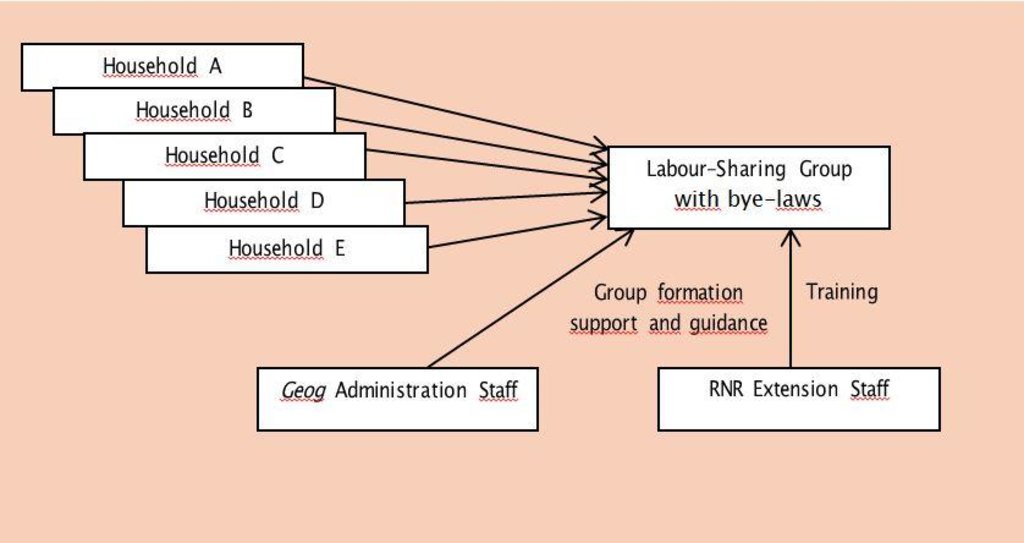SLM Labour-Sharing Group [ប្រទេសប៊ូតង់]
- ការបង្កើត៖
- បច្ចុប្បន្នភាព
- អ្នកចងក្រង៖ Karma Dorji
- អ្នកកែសម្រួល៖ –
- អ្នកត្រួតពិនិត្យ Fabian Ottiger
approaches_2491 - ប្រទេសប៊ូតង់
ពិនិត្យមើលគ្រប់ផ្នែក
ពង្រីកមើលទាំងអស់ បង្រួមទាំងអស់1. ព័ត៌មានទូទៅ
1.2 ព័ត៌មានលម្អិតពីបុគ្គលសំខាន់ៗ និងស្ថាប័នដែលចូលរួមក្នុងការវាយតម្លៃ និងចងក្រងឯកសារនៃវិធីសាស្ត្រផ្សព្វផ្សាយ
ឈ្មោះអង្គភាពមួយ (ច្រើន) ដែលបានចងក្រងឯកសារ/ វាយតម្លៃលើវិធីសាស្ត្រផ្សព្វផ្សាយ (បើទាក់ទង)
MoA (MoA) - ប្រទេសប៊ូតង់ឈ្មោះអង្គភាពមួយ (ច្រើន) ដែលបានចងក្រងឯកសារ/ វាយតម្លៃលើវិធីសាស្ត្រផ្សព្វផ្សាយ (បើទាក់ទង)
National Soil Services Centre (National Soil Services Centre) - ប្រទេសប៊ូតង់1.3 លក្ខខណ្ឌទាក់ទងទៅនឹងការប្រើប្រាស់ទិន្នន័យដែលបានចងក្រងតាមរយៈវ៉ូខេត
តើពេលណាដែលទិន្នន័យបានចងក្រង (នៅទីវាល)?
21/03/2011
អ្នកចងក្រង និង(បុគ្គលសំខាន់ៗ)យល់ព្រមទទួលយកនូវលក្ខខណ្ឌនានាទាក់ទងទៅនឹងការប្រើប្រាស់ទិន្នន័យដែលបានចងក្រងតាមរយៈ វ៉ូខេត:
បាទ/ចា៎
1.4 ការយោងមួយ (ច្រើន) ទៅលើ (កម្រង) បញ្ជីសំណួរនៃបច្ចេកទេស SLM
2. ការពណ៌នាអំពីវិធីសាស្ត្រផ្សព្វផ្សាយ SLM
2.1 ពណ៌នាសង្ខេបខ្លីពីវិធីសាស្ត្រផ្សព្វផ្សាយ
Labour-sharing group at village and sub-village level to ease the labour constraint faced by many households.
2.2 ពណ៌នាលម្អិតពិវិធីសាស្ត្រផ្សព្វផ្សាយ
ពណ៌នាលម្អិតពិវិធីសាស្ត្រផ្សព្វផ្សាយ:
Aims / objectives: A labour-sharing group is a pool of land-users, who work on rotation basis on the plots of the different group members and replaces the conventional approach of an individual land user carrying out a specific SLM intervention. An important constraint for effective implementation of SLM interventions is the lack of sufficient labour force at household level. To tackle this key issue, groups are formed at village and sub-village level to enable these households to take up the relatively labour-intensive SLM activities, such as stone bunding, bench terracing, stone check dam construction, water source protection works or grass hedgerow development.
Methods: The labour-sharing group is given an initial practical training on the basics of the SLM intervention, which start with hands-on work on the land of a group member, preferably that of a vulnerable household, which otherwise would have difficulty to provide sufficient labour to take up the activity. Labour-sharing groups therefore facilitate the inclusion of vulnerable households, especially female-headed and small families, in the implementation of labour-intensive SLM inter-ventions. In addition to the technical guidance provided by the extension staff, support is given to the group formation process, such as drafting of informal by-laws and group management.
Stages of implementation: Labour-sharing groups enable households to carry out key SLM interventions more effectively and efficiently enabling them to cover as compared to individual household approach. Other co-benefits reported are the improved community sense and enhanced social cohesion, because the exchange of experiences and collaboration builds mutual trust. Working in a group eases hard physical work, such as carrying and breaking large boulders and is perceived to be much more enjoyable than working alone or in a small household setting.
Role of stakeholders: Groups that were formed for the implementation of a specific SLM activity often continue carrying our other planned SLM interventions in a group. In some villages communities reported that they had lost the former practice of labour-sharing, but that with reintroduction by the project their community sense has been rejuvenated. Sustainability of the labour-sharing approach has to be proven post-project. Additional costs are very limited and are restricted to group formation guidance and some additional group support, such as tool sets and more incentives as more land will be converted by the group approach.
2.3 រូបភាពនៃវិធីសាស្ត្រផ្សព្វផ្សាយ
2.5 ប្រទេស/តំបន់/ទីតាំងកន្លែង ដែលវិធីសាស្ត្រផ្សព្វផ្សាយត្រូវបានអនុវត្តន៍
ប្រទេស:
ប្រទេសប៊ូតង់
តំបន់/រដ្ឋ/ខេត្ត:
Chhukha Dzongkhag
បញ្ជាក់បន្ថែមពីលក្ខណៈនៃទីតាំង:
Logchina geog, Amallay chiog
2.6 កាលបរិច្ឆេទនៃការចាប់ផ្តើម និងបញ្ចប់នៃវិធីសាស្រ្តផ្សព្វផ្សាយនេះ
សូមបញ្ជាក់ឆ្នាំដែលបានបង្កើតឡើង:
2009
ឆ្នាំបញ្ចប់ (ប្រសិនបើវិធីសាស្ត្រផ្សព្វផ្សាយត្រូវបានឈប់ប្រើប្រាស់):
2012
2.7 ប្រភេទនៃវិធីសាស្ត្រផ្សព្វផ្សាយ
- ផ្អែកលើគម្រោង/កម្មវិធី
2.8 គោលបំណង/ទិសដៅសំខាន់នៃវិធីសាស្ត្រផ្សព្វផ្សាយ
The Approach focused on SLM only
- To ease the existing labour constraint of individual households by pooling labour force into a common pool, ensuring a more time-efficient labour approach, enabling the group to convert larger areas of land.
- To facilitate the inclusion of vulnerable households in more labour-intensive long-term SLM interventions, for which they otherwise would not have the meansto participate.
- To improve community cohesion through improved trust, understanding, social fencing and “labour joy” (“it is much more fun to work in a group than to sweat individually”).
The SLM Approach addressed the following problems: - SLM interventions, as prioritized in chiog SLM action plan, are very labour-intensive, while labour is increasingly becoming a serious constraint in many rural areas of Bhutan, because of rural-urban migration, off-farm labour and other developmental activities.
- Vulnerable households, single-headed families and poorest families, have often the most difficulty providing sufficient labour for long-term SLM interventions
- Communities often face problems in achieving the targeted area of land to be converted to a more sustainable SLM practice, because of labour shortage.
2.9 លក្ខខណ្ឌអនុញ្ញាត ឬរារាំងការអនុវត្តន៍បច្ចេកទេសដែលស្ថិតនៅក្រោមវិធីសាស្រ្តផ្សព្វផ្សាយ
សង្គម/វប្បធម៌/ និងតម្លៃនៃសាសនា
- រារាំង
Some issues with households who do not share sufficient labour / fail to show up
Treatment through the SLM Approach: Informal by-laws, penalty system, social fencing
ក្របខណ្ឌច្បាប់ (សិទ្ធិកាន់កាប់ដីធ្លី កម្មសិទ្ធីប្រើប្រាស់ដីនិងទឹក)
- អំណោយផល
The existing land ownership, land use rights / water rights greatly helped the approach implementation: Individual titled land tenure greatly facilitates motivation and commitment of households to participate in group approach as they are direct beneficiaries.
ទំហំការងារ ភាពអាចរកបាននៃកម្លាំងពលកម្ម
- រារាំង
SLM interventions often require considerable hard physical labour, in a society where labour force increasingly is becoming scarcer.
Treatment through the SLM Approach: Pool individual households in a group and work on rotation basis on each other’s land
3. ការចូលរួម និងតួនាទីរបស់ភាគីពាក់ព័ន្ធ
3.1 អ្នកពាក់ព័ន្ធដែលបានចូលរួមក្នុងវិធីសាស្ត្រផ្សព្វផ្សាយ និងតួនាទីរបស់ពួកគេ
- អ្នកប្រើប្រាស់ដីក្នុងតំបន់/សហគមន៍
self initiative during planning cycle
Slight differences in participation level in the most physically challenging activities such as stone bunding, but also partly culturally determined if there is gender bias in participation. In less physically demanding activities participation is equally divided.The most vulnerable households are included in the labour-sharing group, just as the “better off” families; inclusion of vulnerable households is definite advantage of approach, and an important objective.
- អ្នកឯកទេសគ្រប់គ្រងដីប្រកបដោយចីរភាព/ទីប្រឹក្សាបច្ចេកទេសកសិកម្ម
- រដ្ឋាភិបាលថ្នាក់មូលដ្ឋាន
Local government (geog staff, chiog representatives) and local community
- រដ្ឋាភិបាលថ្នាក់ជាតិ (អ្នករៀបចំផែនការ អ្នកសម្រេចចិត្ត)
3.2 ការចូលរួមរបស់អ្នកប្រើប្រាស់ដីក្នុងតំបន់/ សហគមន៍ក្នុងតំបន់ក្នុងដំណាក់កាលផ្សេងគ្នានៃវិធីសាស្រ្តផ្សព្វផ្សាយ
| ការចូលរួមរបស់អ្នកប្រើប្រាស់ដីក្នុងតំបន់/សហគមន៍ក្នុងតំបន់ | សូមបញ្ជាក់នរណាត្រូវបានចូលរួម ព្រមទាំងពណ៌នាសកម្មភាពទាំងនោះ | |
|---|---|---|
| ការចាប់ផ្តើម/ការលើកទឹកចិត្ត | អន្តរកម្ម | Participatory SLM Action Planning |
| ការរៀបចំផែនការ | អន្តរកម្ម | Participatory SLM Action Planning; Schedule of rotation compiled by group members |
| ការអនុវត្តន៍ | អន្តរកម្ម | Training / capacity building at kick-off of group formation process; stone bunding, hedgerow establishment, bench terracing, stone check dam construction, bamboo and tree plantation, water source protection works and grass strip establishment |
| ការត្រួតពិនិត្យ និងវាយតម្លៃ | អន្តរកម្ម | Participatory Monitoring & Evaluation meetings to give feedback and make adjustments / give guidance |
| Research | គ្មាន |
3.3 គំនូសបំព្រួញ (ប្រសិនបើមាន)
ការពណ៌នា:
Labour-sharing group and its governance
អ្នកនិពន្ធ:
Hans van Noord (Schoutenkamp 43 Heteren The Netherlands)
3.4 ការសម្រេចចិត្តលើការជ្រើសរើសបច្ចេកទេស SLM
សូមបញ្ជាក់តើអ្នកណាជាអ្នកបានសម្រេចចិត្តក្នុងការជ្រើសរើសបច្ចេកទេសដើម្បីយកមកអនុវត្តន៍:
- អ្នកប្រើប្រាស់ដី ដោយមានការគាំទ្រពីអ្នកជំនាញឯកទេស SLM
ចូរពន្យល់:
Decisions on the method of implementing the SLM Technology were made by mainly by land users supported by SLM specialists
4. ជំនួយបច្ចេកទេស ការកសាងសមត្ថភាព និងការគ្រប់គ្រងចំណេះដឹង
4.1 ការកសាងសមត្ថភាព/ បណ្តុះបណ្តាល
តើវគ្គបណ្តុះបណ្តាលបានផ្តល់ឱ្យអ្នកប្រើប្រាស់ដី/អ្នកពាក់ព័ន្ធផ្សេងៗទៀតដែរឬទេ?
បាទ/ចា៎
សូមបញ្ជាក់តើអ្នកណាត្រូវបានបណ្តុះបណ្តាល:
- អ្នកប្រើប្រាស់ដី
ទម្រង់នៃការបណ្តុះបណ្តាល:
- អនុវត្តន៍ជាមួយការងារ
- ពីកសិករទីកសិករ
- ទីតាំងបង្ហាញ
ប្រធានបទបណ្តុះបណ្តាល:
Training programme for specific SLM interventions, carried out by the labour-sharing group after initial capacity building and hands-on practice sessions; additional group formation support and guidance by the municipality administration staff and extension staff.
4.2 សេវាផ្តល់ប្រឹក្សាយោបល់
តើអ្នកប្រើប្រាស់ដីបានទទួលនូវសេវាផ្តល់ប្រឹក្សាដែរ ឬទេ?
បាទ/ចា៎
សូមបញ្ជាក់ប្រសិនបើសេវាកម្មប្រឹក្សាយោបល់ត្រូវបានផ្តល់ឱ្យ:
- នៅលើដីរបស់អ្នកប្រើប្រាស់ដី
- នៅមជ្ឈមណ្ឌលជាអចិន្ត្រៃ
ពណ៌នា/ពន្យល់:
Name of method used for advisory service: Group formation process guidance; Key elements: by-law formulation, demo trainings, exchange visit; By extension staff and geog administration staff in group formation process and during ad hoc visits and regular participatory M & E meetings.
Advisory service is quite adequate to ensure the continuation of land conservation activities; Some need for refreshing/additional training of SLM techniques
4.3 ការពង្រឹងសមត្ថភាពស្ថាប័ន (ការអភិរឌ្ឍន៍អង្គភាព)
តើស្ថាប័នទាំងអស់ត្រូវបានបង្កើតឡើង ឬពង្រឹងសមត្ថភាពតាមរយៈវិធីសាស្ត្រផ្សព្វផ្សាយដែរ ឬទេ?
- បាទ/ច៎ា បានខ្លាំង
សូមបញ្ជាក់ថាតើស្ថាប័នត្រូវបានពង្រឹង ឬបង្កើតឡើងនៅត្រឹមកម្រិតណា(ច្រើន)?
- ថ្នាក់មូលដ្ឋាន
សូមបញ្ជាក់ប្រភេទនៃការគាំទ្រ:
- ហិរញ្ញវត្ថុ
- ការកសាងសមត្ថភាព/ បណ្តុះបណ្តាល
- សម្ភារៈ
សូមផ្តល់ព័ត៌មានបន្ថែមទៀតឱ្យបានលម្អិត:
Group formation process guidance: training and continued support by extension and geog administration staff.
4.4 ការត្រួតពិនិត្យ និងវាយតម្លៃ
តើការត្រួតពិនិត្យ និងវាយតម្លៃគឺជាផ្នែកមួយនៃវិធីសាស្ត្រដែរឬទេ?
បាទ/ចា៎
មតិយោបល់:
bio-physical aspects were regular monitored by project staff, government, land users through measurements; indicators: Regular measurements by project staff and group members: area converted, of dams built etc.
technical aspects were regular monitored by project staff, government, land users through observations; indicators: Regular observations by project staff and group members: implementation according to technical guidelines (distances between bunds/hedges, survival rate of seedlings etc.
socio-cultural aspects were regular monitored by project staff, government, land users through observations; indicators: Regular observations by project and geog administration staff and group members regarding group functioning and possible conflicts (drafting of by-laws, rules etc.)
economic / production aspects were regular monitored by project staff, land users through measurements; indicators: Regular measurements by project staff and group members: crop yield, production area increase
area treated aspects were regular monitored by project staff, land users through measurements; indicators: Regular measurements by project staff and group members: area treated
no. of land users involved aspects were None monitored by project staff, land users through measurements; indicators: Regular measurements by project staff and group members: # of households
management of Approach aspects were None monitored by project staff, government, land users through observations; indicators: Regular M & E meetings with project and geog administration staff and group members
There were few changes in the Approach as a result of monitoring and evaluation: Drafting and adoption of group by-laws to regulate agreements and as enforcement of “social fencing”
There were few changes in the Technology as a result of monitoring and evaluation: slight changes in technical guidelines after group feedback.
5. ថវិកា និងសម្ភារៈឧបត្ថម្ភពីខាងក្រៅ
5.1 ថវិកាប្រចាំឆ្នាំសម្រាប់ផ្សព្វផ្សាយ SLM
ប្រសិនបើចំនួនពិតប្រាកដនៃថវិកាប្រចាំឆ្នាំមិនត្រូវបានដឹងច្បាស់ សូមប្រាប់ពីចន្លោះនៃថវិកានោះ:
- < 2,000
មតិយោបល់ (ឧ. ប្រភពសំខាន់នៃមូលនិធិ/ម្ចាស់ជំនួយចំបង):
Approach costs were met by the following donors: government (SLMP project support: tools, training, incentives): 5.0%; local community / land user(s) (labour contribution): 95.0%
5.2 ការគាំទ្រផ្នែកហិរញ្ញវត្ថុ / សម្ភារៈដែលបានផ្តល់ទៅឱ្យអ្នកប្រើប្រាស់ដី
តើអ្នកប្រើប្រាស់ដីបានទទួលការគាំទ្រផ្នែកហិរញ្ញវត្ថ/សម្ភារៈសម្រាប់ការអនុវត្តន៍បច្ចេកទេសដែរឬទេ:
បាទ/ចា៎
ប្រសិនបាទ/ច៎ា សូមបញ្ជាក់ប្រភេទ(ច្រើន)នៃការគាំទ្រ លក្ខខណ្ឌ និងអ្នកផ្តល់ឱ្យ(ច្រើន):
Incentive per area converted to sustainable SLM practice and seeds/seedlings.
5.3 សូមបញ្ជាក់ពីធាតុចូលត្រូវបានផ្តល់បដិភាគ (រួមទាំងកម្លាំងពលកម្ម)
- សម្ភារៈ
| សូមបញ្ជាក់ ធាតុចូលណាខ្លះដែលបានផ្តល់បដិភាគ | កម្រិតទំហំប៉ុណ្ណា | សូមបញ្ជាក់ពីការបដិភាគ |
|---|---|---|
| ឧបករណ៍ | ផ្តល់ហិរញ្ញវត្ថុទាំងស្រុង | |
- កសិកម្ម
| សូមបញ្ជាក់ ធាតុចូលណាខ្លះដែលបានផ្តល់បដិភាគ | កម្រិតទំហំប៉ុណ្ណា | សូមបញ្ជាក់ពីការបដិភាគ |
|---|---|---|
| គ្រាប់ពូជ | ផ្តល់ហិរញ្ញវត្ថុមួយផ្នែក | maize, mustard, potato, wheat, paddy, vegetables |
មតិយោបល់:
Incentives cover mainly labour contribution as provided by the group members and is mostly only a minor fraction of the actual labour costs.
5.4 ឥណទាន
តើឥណទានដែលបានផ្តល់នៅក្រោមវិធីសាស្ត្រផ្សព្វផ្សាយសម្រាប់សកម្មភាព SLM នេះយ៉ាងដូចម្តេច?
ទេ
6. ការវិភាគរកផលប៉ះពាល់ និងសេចក្តីសន្និដ្ឋាន
6.1 ផលប៉ះពាល់នៃវិធីសាស្ត្រផ្សព្វផ្សាយ
តើវិធីសាស្ត្រផ្សព្វផ្សាយជួយអ្នកប្រើប្រាស់ដីដើម្បីអនុវត្តន៍ និងថែទាំបច្ចេកទេស SLM?
- ទេ
- បាទ/ច៎ា បន្តិចបន្តួច
- បាទ/ច៎ា ជាមធ្យម
- បាទ/ច៎ា បានខ្លាំង
Labour-sharing has resulted in the possibility to convert/treat larger areas per working day and has made the work much easier (lifting of heavy stones etc.). More land has now become cultivated through labour-sharing group involvement as could have been done through individual households.
តើវិធីសាស្ត្រផ្សព្វផ្សាយនេះផ្តល់សិទ្ធិអំណាចដល់សង្គមនិងសេដ្ឋកិច្ចដែលក្រុមមិនទទួលបានផលប្រយោជន៍?
- ទេ
- បាទ/ច៎ា បន្តិចបន្តួច
- បាទ/ច៎ា ជាមធ្យម
- បាទ/ច៎ា បានខ្លាំង
Targeted inclusion of vulnerable households in group, even if they have not sufficient labour to contribute to labour pool; hands-on training starts on land of most vulnerable/poor households to give them first benefit.
Did other land users / projects adopt the Approach?
- ទេ
- បាទ/ច៎ា បន្តិចបន្តួច
- បាទ/ច៎ា ជាមធ្យម
- បាទ/ច៎ា បានខ្លាំង
Other villages have followed the example of the initial groups.
Did the Approach lead to improved livelihoods / human well-being?
- ទេ
- បាទ/ច៎ា បន្តិចបន្តួច
- បាទ/ច៎ា ជាមធ្យម
- បាទ/ច៎ា បានខ្លាំង
Group members express satisfaction over improved social cohesion and interaction because of built trust and understanding and social bonding; group work has contributed to enhanced food self-sufficiency.
Did the Approach help to alleviate poverty?
- ទេ
- បាទ/ច៎ា បន្តិចបន្តួច
- បាទ/ច៎ា ជាមធ្យម
- បាទ/ច៎ា បានខ្លាំង
Through improved food self-sufficiency, increased production area/improved cropland area and targeted inclusion of most vulnerable households that otherwise could not have participated in specific labour-intensive SLM activity
6.2 ការលើកទឹកចិត្តចម្បងៗរបស់អ្នកប្រើប្រាស់ដីសម្រាប់ការអនុវត្តបច្ចេកទេស SLM
- បង្កើនផលិតកម្ម
- កាត់បន្ថយទំហំការងារ
- ការចំណាយ/បដិភាគ
- ការផ្សារភ្ជាប់ទៅនឹងចលនា/គម្រោង/ក្រុម/បណ្តាញ
- ពង្រឹងស្មារតីផ្នែកបរិស្ថាន
6.3 សកម្មភាពផ្សព្វផ្សាយដែលប្រកបដោយចីរភាព
តើអ្នកប្រើប្រាស់ដីអាចធ្វើឱ្យមានចីរភាពនូវអ្វីដែលត្រូវបានអនុវត្តន៍តាមរយៈវិធីសាស្ត្រផ្សព្វផ្សាយដែរឬទេ(ដោយពុំមានការគាំទ្រពីអ្នកខាងក្រៅ)?
- បាទ/ចា៎
ប្រសិនបាទ/ច៎ា សូមរៀបរាប់ថាធ្វើយ៉ាងម៉េច:
Existing group approach seems well suited to continue post-project, also as it partly is a rejuvenated traditional practice to share labour in a community group.
6.4 ភាពខ្លាំង/ គុណសម្បត្តិនៃវិធីសាស្ត្រផ្សព្វផ្សាយ
| ភាពខ្លាំង/ គុណសម្បត្តិ/ ឱកាស ទស្សនៈរបស់អ្នកប្រើប្រាស់ដី |
|---|
|
Eases work (breaking stones, carrying etc.). A-frame running helps to have better lines. Continuous smooth work wit many Social cohesion / experience sharing (How to sustain/ enhance this strength: Continuation of group work Continuation of group work Continued group monitoring and guidance) |
| ភាពខ្លាំង/ គុណសម្បត្តិ/ ឱកាស ទស្សនៈរបស់បុគ្គលសំខាន់ៗ |
|---|
|
Tackles main issue of labour shortage and eases hard physical work (breaking stones, carrying/lifting boulders etc.) Enhances social cohesion and group spirit / community sense; promotes exchange of experiences Facilitates conversion of larger areas of slope segments treated with SLM practices Preferred approach to enhance inclusion of most vulnerable households in labour-intensive SLM practices (How to sustain/ enhance this strength: Continued group monitoring and guidance Continued group monitoring and guidance Continued group monitoring and guidance Start hands-on training work on land of these vulnerable households to give them first benefit) |
6.5 ភាពខ្សោយ/ គុណវិបត្តិនៃវិធីសាស្ត្រ និងរកដំណោះស្រាយ
| ភាពខ្សោយ/ គុណវិបត្តិ/ ហានិភ័យ ទស្សនៈរបស់អ្នកប្រើប្រាស់ដី | តើបច្ចេកទេសទាំងនោះបានដោះស្រាយបញ្ហាដូចម្តេច? |
|---|---|
| Some conflicts in labour-sharing (after completion on their land they abscond). | Attendance register, social control, labour compensation, fines, by-laws. |
| ភាពខ្សោយ/ គុណវិបត្តិ/ ហានិភ័យក្នុងទស្សនៈរបស់បុគ្គលសំខាន់ៗ | តើបច្ចេកទេសទាំងនោះបានដោះស្រាយបញ្ហាដូចម្តេច? |
|---|---|
|
Sustainability has yet to be proven post-project; certain dependency on incentives Loose group structure without formal leadership might threaten sustainability |
Continued group monitoring and guidance by extension and geog administration staff By-laws to formalize some agreements and enforce some penalties |
7. ឯកសារយោង និងវេបសាយ
7.1 វិធីសាស្ត្រ/ ប្រភពនៃព័ត៌មាន
- តាមការចុះទីវាល ការស្រាវជ្រាវនៅទីវាល
- ការសម្ភាសន៍ជាមួយអ្នកប្រើប្រាស់ដី
ការតភ្ជាប់ និងម៉ូឌុល
ពង្រីកមើលទាំងអស់ បង្រួមទាំងអស់ការតភ្ជាប់
គ្មានការតភ្ជាប់
ម៉ូឌុល
គ្មានម៉ូឌុល






